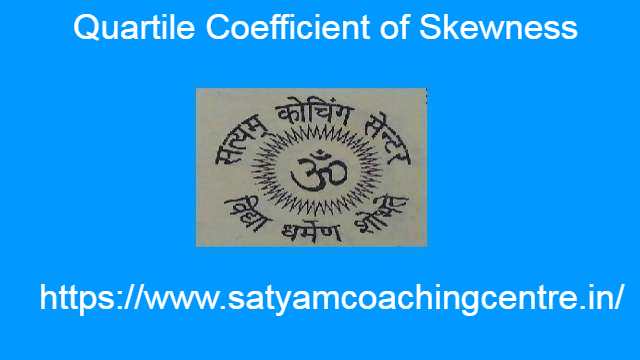Quartile Coefficient of Skewness
1.विषमता का चतुर्थक गुणक (Quartile Coefficient of Skewness),बाउले का विषमता गुणक (Bowley Coefficient of Skewness):
विषमता का चतुर्थक गुणक (Quartile Coefficient of Skewness) डाॅ. ए. एल. बाउले द्वारा प्रतिपादित माप मध्यका और चतुर्थकों पर आधारित है।एक सममित वितरण में मध्यका से प्रथम और तृतीय चतुर्थकों के अन्तर समान दूरी पर होते हैं तथा इनके असमान होने पर वितरण में विषमता पाई जाती है।यह अन्तर जितना अधिक होता है विषमता उतनी ही अधिक होती है।
आपको यह जानकारी रोचक व ज्ञानवर्धक लगे तो अपने मित्रों के साथ इस गणित के आर्टिकल को शेयर करें।यदि आप इस वेबसाइट पर पहली बार आए हैं तो वेबसाइट को फॉलो करें और ईमेल सब्सक्रिप्शन को भी फॉलो करें।जिससे नए आर्टिकल का नोटिफिकेशन आपको मिल सके । यदि आर्टिकल पसन्द आए तो अपने मित्रों के साथ शेयर और लाईक करें जिससे वे भी लाभ उठाए । आपकी कोई समस्या हो या कोई सुझाव देना चाहते हैं तो कमेंट करके बताएं।इस आर्टिकल को पूरा पढ़ें।
Also Read This Article:-Bowley Coefficient of Skewness
2.विषमता का चतुर्थक गुणक पर आधारित उदाहरण (Examples Based on Quartile Coefficient of Skewness):
Example:1.निम्न समंकों से चतुर्थकों व मध्यका पर आधारित विषमता के माप की गणना कीजिएः
(Calculate measure of skewness based on quartiles and median from the following data):
| Variable | Frequency |
| 10-20 | 358 |
| 20-30 | 2417 |
| 30-40 | 976 |
| 40-50 | 129 |
| 50-60 | 62 |
| 60-70 | 18 |
| 70-80 | 10 |
Solution:Calculation Table of Bowley Coefficient of Skewness
| Variable | Frequency(f) | cf |
| 10-20 | 358 | 358 |
| 20-30 | 2417 | 2775 |
| 30-40 | 976 | 3751 |
| 40-50 | 129 | 3880 |
| 50-60 | 62 | 3942 |
| 60-70 | 18 | 3960 |
| 70-80 | 10 | 3970 |
| Total | 3970 |
m=size of \frac{N}{2} th item
=size of \frac{3970}{2} th item
\Rightarrow m =1985 th item
मध्यका समूह 20-30
l_1=20, i=30-20=10, f=2417, c=358
M =l_1+\frac{i}{f}(m-c) \\ =20+\frac{10}{2417}(1985-358) \\ =20+\frac{10}{2417} \times 1627 \\ =20+\frac{16270}{2417} \\ =20+6.731 \\ M \approx 26.73
q_1=size of \frac{N}{4} th item
=\frac{3970}{4} th item
q_1=992.5 th item
चतुर्थक समूह 20-30
l_1=20, i=30-20=10, f=2417 , c=358
Q_1=l_1+\frac{i}{f}(q_{3}-c)\\ =20+\frac{10}{2417}(992.5-358)\\ =20+\frac{10}{2417} \times 634.5\\ =20+\frac{6345}{2417}\\ =20+2.625\\ Q_1=22.625
q_3=size of \frac{3 N}{4} th item
=\frac{3 \times 3970}{4} th item
=\frac{11910}{4} th item
q_3=2977.5 th item
चतुर्थक समूह 30-40
l_1=30, i=40-30=10, f=976,c=2775
Q_3=l_1+\frac{i}{f}\left(q_3-c\right)\\ =30+\frac{10}{976}(2977.5-2775)\\=30+\frac{10}{976} \times 202.5\\=30+\frac{2025}{976}\\ =30+2.0747 \\ Q_3=32.0747\\ Q_3 \approx 32.07\\ J_Q=\frac{Q_3+Q_1-2 M}{Q_3-Q_1}\\ =\frac{32.07+22.625-26.73 \times 2}{32.07-22.625}\\ =\frac{54.695-53.46}{9.445}\\ =\frac{1.235}{9.445} \\ =0.1307 \\ J_Q \approx 0.131
Example:2.निम्नलिखित से विषमता के चतुर्थक माप की गणना कीजिएः
(Calculate quartile measure of skewness from the following data):
| Class | Frequency |
| 0-10 | 2 |
| 0-20 | 5 |
| 0-30 | 10 |
| 0-40 | 20 |
| 0-50 | 45 |
| 0-60 | 65 |
| 0-70 | 77 |
| 0-80 | 87 |
| 0-90 | 95 |
| 0-100 | 100 |
Solution:Calculation Table of Bowley Coefficient of Skewness
| Class | Frequency(f) | cf |
| 0-10 | 2 | 2 |
| 10-20 | 3 | 5 |
| 20-30 | 5 | 10 |
| 30-40 | 10 | 20 |
| 40-50 | 25 | 45 |
| 50-60 | 20 | 65 |
| 60-70 | 12 | 77 |
| 70-80 | 10 | 87 |
| 80-90 | 8 | 95 |
| 90-100 | 5 | 100 |
| Total | 100 |
m=size of \frac{N}{2} th item
=size of \frac{150}{2} th item
m=50 th item
मध्यका समूह 50-60
l_1=50, i=60-50=10, f=20, c=45
M=l_1+\frac{i}{f}(m-c)\\ =50+\frac{10}{20}(50-45)\\ =50+\frac{1}{2} \times 5\\ =50+2.5\\ M=52.5
q_1=size of \frac{N}{4} th item
= size of \frac{100}{4} th item
\Rightarrow q_{1}=25 th item
चतुर्थक समूह 40-50
l_1=40, i=50-40=10, f=25, c=20
Q_{1}=l_1+\frac{i}{f}\left(q_p-c\right)\\ =40+\frac{10}{25}(25-20)\\ =40+\frac{10}{25} \times 5\\ =40+2\\ Q_1=42
q_3=size of \frac{3 N}{4} \text th item
=size of \frac{3 \times 100}{4} th item
=size of \frac{3 \times 100}{4} th item
चतुर्थक समूह 60-70
l_1=60, i=70-60=10, f=12, c=65
Q_3=l_1+\frac{i}{f}\left(q_3-c\right)\\ =60+\frac{10}{12}(75-65)\\ =60+\frac{10}{12} \times 10\\ =60+8.333\\ Q_3 \approx 68.33 \\ J_Q =\frac{Q_3+Q_1-2 M}{Q_3-Q_1} \\ =\frac{68.33+42-2 \times 52.5}{68.33-42} \\ \Rightarrow J_{Q}=\frac{110.33-105}{26.33} \\ =\frac{5.33}{26.33} \approx 0.20
Example:3.निम्न समंकों से बाउले के विषमता गुणक का परिकलन कीजिएः
(Calculate Bowley’s Coefficient of Skewness from the following data):
| Size of collar(cm) | No. of shirts |
| 0 | 1 |
| 2 | 3 |
| 3 | 2 |
| 4-5 | 4 |
| 6-9 | 7 |
| 10-14 | 3 |
| 15-25 | 1 |
Solution:Calculation Table of Bowley Coefficient of Skewness
| Size of collar | No. of shirts(f) | cf |
| 0-2.5 | 4 | 4 |
| 2.5-3.5 | 2 | 6 |
| 3.5-5.5 | 4 | 10 |
| 5.5-9.5 | 7 | 17 |
| 9.5-14.5 | 3 | 20 |
| 14.5-25.5 | 1 | 21 |
| Total | 21 |
m= size of \frac{N}{2} th item
=size of \frac{21}{2} th item
m=10.5 th item
मध्यका वर्ग 5.5-9.5
l_1=5.5, i=9.5-5.5=4, f=7, c=10
M=l_1+\frac{i}{f}\left(m-c\right)\\ =5.5+\frac{4}{7}(10.5-10)\\ =5.5+\frac{4 \times 0.5}{7}\\ M =5.5+\frac{2}{7} \\ =5.5+0.2857 \\ =5.7857 \\ M \approx 5.8
q_1=size of \frac{N}{4} th item
=size of \frac{21}{4} th item
=5.25 th item
चतुर्थक वर्ग 2.5-3.5
l_1=2.5 ,c=3.5-2.5=1, f=2, c=4
Q_1=l_1+\frac{i}{f}\left(q_1-c\right) \\ =2.5+\frac{1}{2}(5.25-4) \\ =2.5+\frac{1}{2} \times 1.25 \\ =2.5+0.625 \\ \Rightarrow Q_1 =3.125
q_{3}=size of \frac{3N}{4} th item
q_{3}=size of \frac{3 \times 21}{2} th item
q_3=15.75 th item
चतुर्थक वर्ग 5.5-9.5
l_1=5.5, i=9.5-5.5=4, f=7, c=10
Q_3=l_1+\frac{i}{f}\left(q_3-c\right) \\ \Rightarrow Q_3=5.5+\frac{4}{7}(15.75-10)\\ =5.5+\frac{4}{7} \times 5.75\\ =5.5+\frac{23}{7}\\ =5.5+3.2857\\ =8.7857\\ Q_3 \approx 8.8\\ J_Q=\frac{Q_3+Q_1-2 M}{Q_3-Q_1} \\ J_Q =\frac{8.8+3.125-2 \times 5.8}{8.8-3.125}\\=\frac{11.925-11.6}{5.675} \\ =\frac{0.325}{5.675}=0.0572 \\ \Rightarrow J_Q =+0.057
Example:4.निम्नलिखित समंकों से कार्ल पियर्सन का मध्यका पर आधारित विषमता गुणांक ज्ञात कीजिएः
(From the following data, calculate Karl Pearson’s Coefficient of Skewness based on median):
| Marks | No. of students |
| less than 20 | 08 |
| less than 30 | 38 |
| less than 40 | 53 |
| 40-50 | 02 |
| 50-60 | 08 |
| 60-70 | 30 |
| more than 70 | 17 |
| more than 80 | 04 |
Solution:Calculation Table of Karl Pearson Coefficient of Skewness
| No. of | Mid value | A=45 | fd^{2}x' | |||
| Marks | students(f) | X | dx’ | fdx’ | cf | |
| 10-20 | 08 | 15 | -3 | -24 | 72 | 8 |
| 20-30 | 30 | 25 | -2 | -60 | 120 | 38 |
| 30-40 | 15 | 35 | -1 | -15 | 15 | 53 |
| 40-50 | 02 | 45 | 0 | 0 | 0 | 55 |
| 50-60 | 08 | 55 | 1 | 8 | 8 | 63 |
| 60-70 | 30 | 65 | 2 | 60 | 120 | 93 |
| 70-80 | 13 | 75 | 3 | 39 | 117 | 106 |
| 80-90 | 4 | 85 | 4 | 16 | 64 | 110 |
| Total | 110 | 24 | 516 |
\bar{X}=A+\frac{\sum fd x^{\prime}}{N} \times i \\ =45+\frac{24}{110} \times 10 \\ =45+2.181 \\ =47.181 \\ \bar{X} \approx 47.18
m =value of \frac{N}{2} th item
=value of \frac{110}{2} th item
m =55 th item
मध्यका वर्ग 40-50
l_{1}=40,i=50-40=10,f =2, c=53
M =l_{1}+\frac{i}{f}(m-c) \\ =40+\frac{10}{2}(55-53) \\ =40+\frac{10}{2} \times 2 \\ =40+10 \\ \Rightarrow M =50 \\ \sigma =\frac{i}{N} \sqrt{\sum f d^2 x^{\prime} N-(f d x^{\prime})^2} \\ =\frac{10}{110} \sqrt{516 \times 110-(24)^2} \\ =\frac{1}{11} \sqrt{56760-576} \\ =\frac{1}{11} \sqrt{56184} \\ =\frac{1}{11} \times 237.0316 \\ =21 .5483 \\ \sigma \approx 21.548 \\ J= \frac{3(\bar{X}-M)}{\sigma}=\frac{3(47.18-50)}{21.548} \\ =\frac{3 \times-2.82}{21.548} \\=\frac{-8.46}{21.548}=-0.3926 \\ J\approx -0.39
Example:5.निम्नलिखित समंकों से बाउले की रीति से विषमता गुणांक का परिकलन कीजिएः
(Calculate Coefficient of Skewness by Bowley’s Method from the following data):
| Size | Freq. |
| less than 5 | 07 |
| less than 10 | 20 |
| 5-15 | 38 |
| 15 & above | 55 |
| 20-25 | 20 |
| 25 & above | 05 |
| 30 & above | 01 |
Solution:Calculation Table of Bowley Coefficient of Skewness
| Size | Frequency(f) | cf |
| 0-5 | 7 | 7 |
| 5-10 | 13 | 20 |
| 10-15 | 25 | 45 |
| 15-20 | 30 | 75 |
| 20-25 | 20 | 95 |
| 25-30 | 4 | 99 |
| 30-35 | 1 | 100 |
| Total | 100 |
m=size of \frac{M}{2} th item
=size of \frac{100}{2} th item
m=50 th item
मध्यका वर्ग 15-20
l_1=15,i=20-15=5, f=30, c=45
M=l_1+\frac{i}{f}(m-c)\\ =15+\frac{5}{30}(50-45)\\=15+\frac{1}{6} \times 5 \\ =15+0.833 \\=15.833 \\ M \approx 15.833
q_1=size of \frac{N}{4} th item
q_1=size of \frac{100}{4} th item
q_1=size of 25 th item
चतुर्थक वर्ग 10-15
l_1=10, i=15-10=5, f=25, c=20
Q_1=l_1+\frac{i}{f}\left(q_1-c\right) \\ =10+\frac{5}{25}(25-20) \\ =10+\frac{5}{25} \times 5 \\ =10+\frac{25}{25} \\ =10+1 \\ Q_1=11 \\ Q_1 \approx 11
q_3=size of \frac{3 N}{4} th item
=size of \frac{3 \times 100}{4} th item
=size of \frac{300}{4} th item
q_3=size of 75 th item
चतुर्थक वर्ग 15-20
l_1=105,i=20-15=5, f=30, c=45
Q_3 =l_1+\frac{i}{f}\left(q_{3}-c\right)\\ =25+\frac{5}{30}\left(75-45\right) \\ =25+\frac{1}{6} \times 30 \\ =25+5 \\ =20\\ Q_3 =20 \\ J_Q=\frac{Q_3+Q_1-2 M}{Q_3-Q_1} \\ =\frac{20+11-2 \times 15.83}{20-11} \\ =\frac{31-31.66}{9} \\ =-\frac{0.66}{9} \\ =-0.0733 \\ J_Q \approx -0.073
Example:6.निम्नलिखित से विषमता चतुर्थक माप तथा उसका गुणांक ज्ञात कीजिएः
(Find the Quartile Measure of Skewness and its Coefficient from the following):
| Variable | Frequency |
| 0-5 | 2 |
| 5-10 | 5 |
| 10-15 | 7 |
| 15-20 | 18 |
| 20-25 | 21 |
| 25-30 | 16 |
| 30-35 | 8 |
| 35-40 | 3 |
Solution:Calculation Table of Bowley Coefficient of Skewness
| Variable | Frequency(f) | cf |
| 0-5 | 2 | 2 |
| 5-10 | 5 | 7 |
| 10-15 | 7 | 14 |
| 15-20 | 18 | 32 |
| 20-25 | 21 | 53 |
| 25-30 | 16 | 69 |
| 30-35 | 8 | 77 |
| 35-40 | 3 | 80 |
| Total | 80 |
m=size of \frac{N}{2} th item
= size of \frac{80}{2} th item
=40 th item
मध्यका वर्ग 20-25
l_1=20, i=25-20=5, f=21, c=32
M=l_{1}+\frac{i}{f}(m-c) \\ =20+\frac{5}{21}(40-32) \\ =20+\frac{5}{21} \times 8 \\ =20+\frac{40}{21} \\ =20+1.9047 \\ =21.9047 \\ M \approx 21.905
q_1=size of \frac{N}{4} th item
q_1=size of \frac{80}{4} th item
q_1=20 th item
चतुर्थक वर्ग 15-20
l_1=15,i=20-15=5, f=18, c=14
Q_1=l_1+\frac{1}{f}\left(q_1-c\right)\\ =15+\frac{5}{18}(20-14) \\ =15+\frac{5}{18} \times 6 \\ =15+\frac{30}{18} \\ =15+1.6666 \\=16.6666 \\ \Rightarrow Q_1=16.667
q_3= size of \frac{3 N}{4} th item
=size of \frac{3 \times 80}{4} th item
\Rightarrow q_3=60 th it em
चतुर्थक वर्ग 25-30
1_{1}=25 i=30-25=5, f=16, c=53
Q_3 =l_1+\frac{i}{f}\left(q_3-c\right) \\ =25+\frac{5}{16}(60-53) \\ =25+\frac{5}{16} \times 7 \\ =25+\frac{35}{16} \\ =25+2.1875 \\ =27.1875 \\ \Rightarrow Q_3 \approx 27.188 \\ S K_Q=Q_3+Q_1-2 M\\ =27.188+16.667-2 \times 21.905\\ S K_{Q}=43.855-43.81\\ =43.855-43.81 \\ SK_{Q}=+0.045\\ J_{Q}=\frac{Q_3+Q_1-2 M}{Q_3-Q_1}\\ =\frac{27 \cdot 188+16.667-2 \times 21.905}{27.188-16.667}\\= \frac{43.855-43.81}{10.521} \\ =\frac{0.045}{10.521}=0.00427 \\ J_{Q} \approx 0.0043
Example:7.निम्न सूचनाओं के आधार पर कार्ल पियर्सन का विषमता गुणक तथा डाॅ. बाउले के विषमता गुणक का परिकलन कीजिएः
(From the following data calculate Karl Pearson’s Coefficient of Skewness and Bowley’s Coefficient of Skewness):
| Measure | Place A | Place B |
| Mean | 256.5 | 240.8 |
| Median | 201.0 | 201.6 |
| std. Deviation | 215.4 | 181.1 |
| Third Quartile | 260 | 242.0 |
| First Quartile | 157.0 | 164.2 |
Solution:Calculation Table of Karl Pearson’s Coefficient
Place A:
\bar{X} =256.5 \\ M =201.0 \\ \sigma =215-4 \\ J_M =\frac{3(\bar{X}-M)}{\sigma} \\ =\frac{3(256.5-201)}{215.4} \\ =\frac{3 \times 55.5}{215-4} \\ =\frac{166.5}{215.4} \\ =0.7729 \\ \Rightarrow J_M \approx 0.773
Place B:
\bar{x}=240.8 \\= M=201.6 \\ \sigma=181.1 \\ J_M=\frac{3(\bar{x}-M)}{\sigma} \\ = \frac{(240.8-201.6)}{181.1} =\frac{3 \times 39.2}{181.1} \\ =\frac{117.6}{181.6} \\=0.6475 \\ J_{M} \approx 0.648
Calculation of Bowley Coefficient of Skewness
Place A:
Q_1=157, Q_3=260, \quad M=201 \\J_Q =\frac{Q_3+Q_1-2 M}{Q_3 \perp Q_1} \\ =\frac{260+157-2 \times 201}{260-157} \\ =\frac{417-402}{103} \\ =\frac{15}{103} \\ \Rightarrow J_{Q} =0.1456 \\ J_Q \approx +0.146
Place B:
Q_1=164.2, Q_3=242.0, M=201.6 \\ J_Q =\frac{Q_3+Q_1-2 M}{Q_2-Q_1} \\ =\frac{242+164.2-2 \times 201.6}{242-164.2} \\ =\frac{406.2-403.2}{78} \\ =\frac{3}{78} \\ =0.03846 \\ \Rightarrow J_{Q} \approx 0.038
उपर्युक्त उदाहरणों के द्वारा विषमता का चतुर्थक गुणक (Quartile Coefficient of Skewness),बाउले का विषमता गुणक (Bowley Coefficient of Skewness) को समझ सकते हैं।
3.विषमता का चतुर्थक गुणक पर आधारित सवाल (Questions Based on Quartile Coefficient of Skewness):
(1.)निम्नलिखित सारणी से चतुर्थक विचलन तथा विषमता गुणांक,चतुर्थकों तथा मध्यका को मालूम करके निकालिएः
(From the following table,calculate the coefficient of quartile deviation and coefficient of quartile skewness with the help of median and quartiles):
| Measurement | Frequency |
| 4-8 | 6 |
| 8-12 | 10 |
| 12-16 | 18 |
| 16-20 | 30 |
| 20-24 | 15 |
| 24-28 | 12 |
| 28-32 | 10 |
| 32-36 | 6 |
| 36-40 | 2 |
(2.)निम्न सारणी से अपकिरण का चतुर्थक गुणांक और विषमता गुणांक और विषमता का चतुर्थक गुणांक ज्ञात कीजिएः
| प्राप्तांक | आवृत्ति |
| 0-10 | 3 |
| 10-20 | 9 |
| 20-30 | 15 |
| 30-40 | 24 |
| 40-50 | 12 |
| 50-60 | 8 |
| 60-70 | 7 |
| 70-80 | 5 |
उत्तर (Answers):(1.)Q.D.=5.21 , J_Q=0.1881
(2.) C of Q.D.=0.313, M=36.04, Q_1=25.83, Q_3=49.38,J_{Q}= +0.133
उपर्युक्त सवालों को हल करने पर विषमता का चतुर्थक गुणक (Quartile Coefficient of Skewness),बाउले का विषमता गुणक (Bowley Coefficient of Skewness) को ठीक से समझ सकते हैं।
Also Read This Article:-Karl Pearson’s Coefficient of Skewness
4.विषमता का चतुर्थक गुणक (Quartile Coefficient of Skewness),बाउले का विषमता गुणक (Bowley Coefficient of Skewness) से सम्बन्धित अक्सर पूछे जाने वाले प्रश्नः
प्रश्न:1.केली का विषमता माप किस पर आधारित है? (Kelly’s Measure of Skewness is Based on):
उत्तर:केली का माप कार्ल पियर्सन के विषमता माप तथा बाउले के विषमता माप का मध्य मार्ग है।कार्ल पियर्सन का माप एक वितरण की समस्त मदों पर आधारित होता है जबकि डाॅ. बाउले का माप मध्य की 50% मदों पर ही आधारित है।केली के माप के अन्तर्गत मध्य की 80% मदों पर ध्यान दिया जाता है तथा 10% दोनों ओर के चरम मूल्यों को छोड़ दिया जाता है।इस माप के अन्तर्गत वितरण के 90वाँ शतमक और 10वाँ शतमक (अथवा दशमक 9 व दशमक 1) के मध्य की मदों पर ध्यान दिया जाता है। इस माप पर आधारित सूत्र निम्नवत हैः
Skewness(SK)=P_{90}-P_{10}-2 P_{50} or D_9+D_1-2 D_5
coefficient of Skewness \left(J_P\right)=\frac{P_{90}+P_{10}-2 P_{50}}{P_{90}-P_{10}} \text { or } \frac{P_9+D_1-2 D_5}{D_{9}-D_1}
केली द्वारा प्रस्तावित विषमता का माप बहुत सरल है किन्तु यह वितरण की मात्र 80% भाग की विषमता का ही मापन करती है अतः इसका व्यवहार में प्रयोग बहुत कम किया जाता है।
प्रश्न:2.आपकिरण की घात का विषमता का माप का प्रयोग कम क्यों किया जाता है? (Why is Less of the Moments Measure of Skewness Used?):
उत्तर:विषमता का यह माप अपकिरण की घातों पर आधारित है।प्रो. किंग (king) ने इस माप को बहुत अच्छा माना है किन्तु इसकी गणना क्रिया बहुत ही कठिन होने के कारण व्यावहारिक दृष्टि से इसका प्रयोग कम किया जाता है।यह माप घन तथा घनमूल की सहायता से ज्ञात किया जाता है।यह माप इस मान्यता पर आधारित है कि समान्तर माध्य से लिए गए विचलनों का योग शून्य होता है।इसका निरपेक्ष माप अपकिरण की तृतीय घात का घनमूल होता है तथा विषमता गुणक तृतीय घात को प्रमाप विचलन (S.D.) से भाग देने पर प्राप्त होता है।यह माप विषमता का तृतीय माप (Third measure of dispersion) भी कहलाता है।
प्रश्न:3.मौरिस हमबर्ग के अनुसार विषमता का क्या अर्थ है? (What Does Skewness Mean According to Maurice Humberg?):
उत्तरःमौरिस हमबर्ग के मतानुसार, “विषमता एक आवृत्ति वितरण से असममितता और सममितता के अभाव को आकार के रूप में बतलाता है।यह लक्षण केन्द्रीय प्रवृत्ति के कुल मापों के प्रतिनिधि (Typicalities) का निर्णय हेतु विशेष महत्त्व का है।
उपर्युक्त प्रश्नों के उत्तर द्वारा विषमता का चतुर्थक गुणक (Quartile Coefficient of Skewness),बाउले का विषमता गुणक (Bowley Coefficient of Skewness) के बारे में ओर अधिक जानकारी प्राप्त कर सकते हैं।
| No. | Social Media | Url |
|---|---|---|
| 1. | click here | |
| 2. | you tube | click here |
| 3. | click here | |
| 4. | click here | |
| 5. | Facebook Page | click here |
| 6. | click here |
Quartile Coefficient of Skewness
विषमता का चतुर्थक गुणक
(Quartile Coefficient of Skewness)
Quartile Coefficient of Skewness

विषमता का चतुर्थक गुणक (Quartile Coefficient of Skewness) डाॅ. ए. एल. बाउले द्वारा
प्रतिपादित माप मध्यका और चतुर्थकों पर आधारित है।एक सममित वितरण में मध्यका से
प्रथम और तृतीय चतुर्थकों







